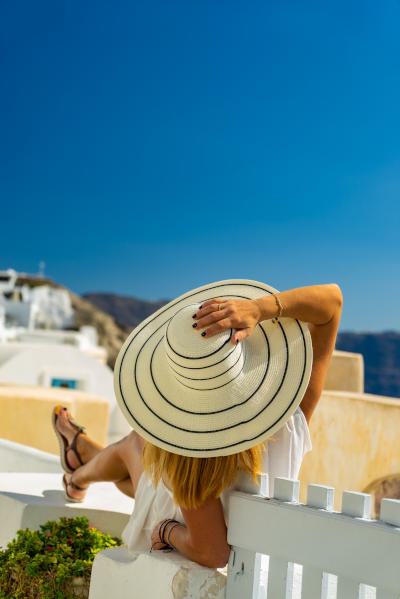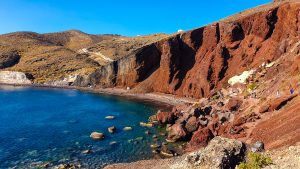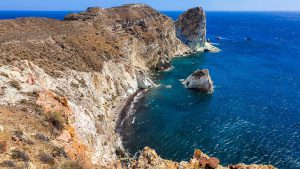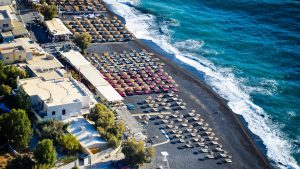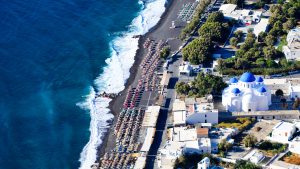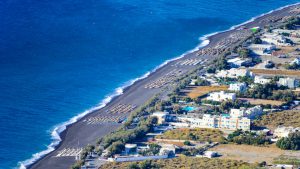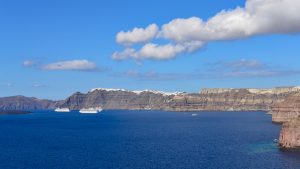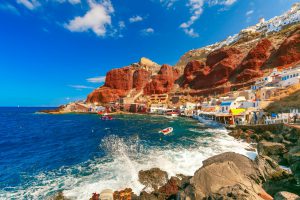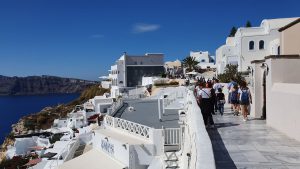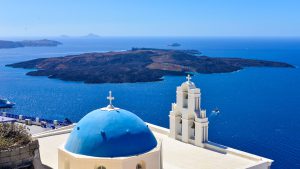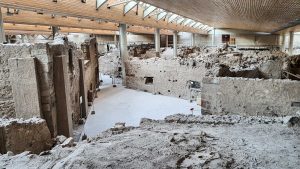Prehistoric Akrotiri on Santorini was one of the most important settlements in the Aegean Sea. Today it continues to challenge historians and archaeologists. It is also a fantastic place for tourists and a must-see on every tourist map. It’s no wonder. After the volcanic eruption the town was covered by a layer of volcanic ash which preserved many of its buildings, frescoes and other works of art as well as everyday objects that we can admire today.
Akrotiri is sometimes called the Greek Pompeii. When reading about these two places, it is difficult not to notice the similarities between them. However, we also find many differences. One of them is the age of both cities – when Pompeii was just developing (7th century BC), Akrotiri had been already covered with a layer of ash for more than thousand years…
The Minoan civilization was 2-3 thousand years ahead of other European civilizations. After its collapse it took a long time to reach the same level of development again….
History of the prehistoric Akrotiri on Santorini
The site of Akrotiri (whose ancient name is unfortunately unknown) is estimated to have been inhabited in the Late Neolithic, at least 4,000 BC, or even 5,000 BC. At that time it was a small fishing and agricultural settlement (mainly grains and olives were grown). In the early Bronze Age (3,000 BC) Akrotiri began to develop, so that by the end of the third millennium BC it had become a significant settlement. Akrotiri had its own merchant fleet and was located on the main sea route between Cyprus and Crete. In addition to that, it had trade contacts with mainland Greece, the Dodecanese, Cyprus, Syria and Egypt and perhaps even with India, as suggested by the wall paintings of “blue monkeys”, whose appearance, according to specialists, resembles gray langurs native to the Indian subcontinent.
The city was large (about 20 ha), very developed and wealthy, as evidenced by the cobblestone streets, extensive drainage system, specialization in crafts, multi-story buildings with frescoes covering the walls, equipped with luxurious furniture, household items and appliances.
The inhabitants of Akrotiri specialized in copper processing, among other things (as evidenced by tools, moulds and melting pots found at the site).
Volcanic eruption and the fall of Akrotiri on Santorini
The state of such prosperity lasted almost a whole millennium. After this time, in the sixteenth century BC, there was a volcanic eruption, considered one of the largest in history.
It devastated Akrotiri and the rest of the island by covering it with a layer of volcanic ash, which in some places reached a thickness of 40 meters. A layer of ash also fell on Rhodes and Crete, and traces of ash were even found in remote Greenland.
The exact date of the eruption of Santorini is not known. Radiocarbon dating has revealed that it may have been between 1620 and 1530 BC. A date range of 1570 – 1500 B.C. has also been suggested due to the similarity of cultural and craft products at Akrotiri with other sites, mainly Minoan Crete. However, the exact date is still debated and disputed among archaeologists and geologists.
It is known that before the volcanic eruption itself, the island of Santorini was hit by an earthquake with a magnitude of 7 on the Richter scale, which caused waves about 9 meters high. It largely destroyed the city (witness the remains of collapsed buildings, as well as traces of attempts to rebuild them). The eruption followed a few days later, spewing 15 billion tons of magma into the air, up to 32 kilometers (20 miles) high, and causing a tsunami as high as 100 meters (330 feet).
Santorini lays in an area prone to relatively frequent earthquakes. One is known to have occurred about 50 years before the great Minoan eruption. The ancient city of Akrotiri shows evidence of being rebuilt many times and buildings repaired. Streets were cleared of rubble and the remaining material was piled against the walls of buildings. The layer of rubble and dust that remained after the earthquake reached the second floor in some places, for this reason the first floors of some buildings became cellars, new entrances were added leading directly to the floor.
The most interesting finds from the site of Akrotiri on Santorini
Akrotiri is attributed to the Minoan culture because of the great similarity of the found frescoes and artifacts to those from other sites of the Minoan civilization and because of the presence of inscriptions written in linear A script.
Some of the most interesting artifacts found at the excavation site include:
Frescoes
One of the most significant finds at Akrotiri are the frescoes. The technique of their creation, however, differs from the typical way a fresco is made. This is because fresco painting at Akrotiri began when the plaster was wet, but was finished on an already dry surface. The pigments used for painting were derived from minerals, which contributed to the durability of the work. The following colors were used: white, yellow, red, blue, brown and black.
Minoan art and culture are still being studied and analyzed. Frescoes from Akrotiri are very well preserved, much better than those from Knossos in Crete.
The discovery of the frescoes has raised many questions, such as what their function was, in what parts of the interior they appeared, whether the paintings on the same wall but of different scales and levels should be read separately or together as a whole, whether the fact that the frescoes appear in the same room somehow links them together…These and many other questions are still waiting for answers.
Ceramics
Much of the artifacts are ceramics, as this is the most durable and common storage container used in ancient societies. A very large number of different types of clay vessels were found at Akrotiri. They were very well preserved – some even contained leftover contents (such as oil). They had different uses (some were for practical purposes – such as storing and keeping objects, eating and cooking, and others for ritual and religious purposes). They differed from each other in size, shape, and painted patterns. Many vessels were decorated with paintings of animals (such as lions, wild goats, dolphins and swallows), and plants (flowers, grasses, reeds).
Furniture
As a result of volcanic ash entering the interiors of houses, negatives of wooden objects were created. These negatives can be used as molds and thus create casts of furniture or parts of furniture. Among other things, the remains of tables, stools, beds, cupboards and dressers have been found.
Figurines and statues
The National Archaeological Museum in Athens exhibits an interesting collection of Akrotiri figurines, including vessels in the shape of animal heads, probably used for pouring wine.
One of the most interesting figurines found at the site of Akrotiri is a golden statue representing a goat – discovered in 1999 (it was hidden in a wooden box placed in a clay box). It was made using the lost-wax method (making a wax prototype, then taping it, removing the wax and filling the form with liquid metal), and protruding elements were soldered. The figure can be seen at the Prehistoric Thera Museum in Fira.
Also found:
- furnishings of prehistoric bathrooms, such as bathtubs,
- stoves, olive lamps,
- sacrificial tables decorated in the same technique as the walls,
- bronze and metal objects, tools.
However, if you go to visit the excavations of Akrotiri, you can see only a few of the things mentioned above, because most of them are now in the Archaeological Museum of Fira, and some of the frescoes and artifacts are in the National Archaeological Museum of Athens.
Archaeological site
Due to the fact that Akrotiri was an entire city, the excavations are divided into 4 sectors with building complexes and buildings. Let’s take a look at the most interesting of them.
Building complexes:
Building Complex Alpha
The Alpha sector consists of two buildings with their walls touching each other. These are smaller houses most likely belonging to less wealthy residents.
- The Alpha East house (Alpha-East) is a two-story building with a built-up area of about 100 m2 and a total area of 200 m2. It is completely excavated. Part of the building most likely served as a store (remains of shelves and many storage vases – pitos – were found, which were left at Akrotiri and can be viewed at the original find site). A hearth, a sizable cooking pot, and tools were also discovered in one of the rooms. In another there was most likely a weaving workshop.
- The Alpha-West House is a partially excavated building, in which the remains of a grain mill were found, among other things. An interesting feature is the preserved trace of a hinge and a bolt in a door.
Building Complex Beta
This was a two-story private house located in the southern part of the Akrotiri excavations. It has an area of approximately 260 m2. It is believed to have consisted of two interconnected buildings (the Beta-North building and the Beta-South building).
They housed the famous frescoes:
- Antelopes (now on display at the National Archaeological Museum in Athens)
- Boxing Boys (now on display at the National Archaeological Museum of Athens)
- Monkeys climbing a rocky riverbank (now on display at the Prehistoric Thera Museum in Fira, Santorini)
In addition, the southern building housed a storehouse containing large clay vessels (called “pitos”) standing in rows, as well as a kitchen full of pottery for cooking and storing food.
The eastern part of both houses was severely damaged by heavy rains and a creek flowing through the area.
Building Complex Gamma
The Gamma Sector is located west of the Beta Sector, on Telchines Street, and is only partially excavated. It consists of two houses separated by a narrow street (the gamma-south building to the north and the gamma-north building to the south). The buildings were heavily damaged during an earthquake that occurred about 50 years before the Minoan eruption. The accumulated debris and volcanic ash reached a height of about 1.5 meters.
From the furnishings in the northern building (beds and clay pots and tools lying nearby), it can be inferred that it served as a temporary infirmary for injured victims of the earthquake. Modifications and repairs of the building after the cataclysm are also visible.
In the south building, on the other hand, evidence was found that the walls were reinforced after the earthquake and the former second floor was converted into a semi-basement. An entrance leading directly to the second floor was also added and probably the most damaged wing of the building was cut off (the door was bricked up). The presence of stone and metal tools indicates that the building housed a workshop.
A fresco fragment with a spiral drawing was also found in the Gamma sector.
Building Complex Delta
It consists of four houses, located in the central part of the excavations:
- South Delta House (Delta-South) – two-storey house, with a building area of 159 m2 and a total area of 264 m2. One of the rooms was used as a weaving workshop, and there was a veranda upstairs. Pitos vases were found in the building.
- West Delta House (Delta-West) – a two-story building with a built-up area of 189 m2 and a total area of 389 m2. Findings included a room used as a bathroom with a large number of clay vessels and a bathtub, and a weaving workshop with large windows facing the Triangular Square.
- Delta-North House (Delta-North, Xeste 1) – a three-story building with a built-up area of 137 m2 and a total area of 319 m2. Among other things, it was found to contain three storage chests constructed of silt bricks.
- Delta-East House (Delta-East) – the smallest of the buildings discovered at Akrotiri with a built-up area of about 96 m2 and a total area of 192 m2.
A number of interesting artifacts were found inside. These include objects made of precious stones and bronze and imported ceramics. In addition, the eastern building contained a fresco depicting a rocky landscape with lilies in bloom and swallows flying between the flowers (the famous spring fresco). A script with linear A writing was also found in this building.
Some of the most impressive buildings:
West house
It was a medium-sized three-story building developed in a thoughtful manner. The built-up area of the building was about 147 m2, and the total area of all floors was over 345 m2. It is located in the western part of the excavations (hence its name).
On the first floor of the building there were 8 rooms, which were occupied by warehouses, workshops and a kitchen. A mill for grinding grain into flour was also found. On the first floor, comprising 7 rooms, there were rooms for weaving, for storing clay vessels, two rooms with wall paintings and a toilet (from which a clay drainage pipe led to the drainage system under the house). Two frescoes depicted fishermen and another one depicted a young priestess. The room was also decorated with a frieze of a flotilla (a frieze is a long, decorative piece of wall near the ceiling, carved or painted) that ran around all the walls and depicted an overseas voyage during which the ships stopped at several ports to finally reach their destination, the ancient port of Akrotiri. On the third and last floor there was 1 room.
House of the Ladies
This is also a fairly large, three-story building with a skylight (window in the roof) in the center. There were 10 rooms on each floor. The built-up area of the building was about 184 m2, and the total area of all floors was over 460 m2.
It was probably a private house belonging to rich residents of the town. It owes its name to a fresco with Ladies and Papyrus (Cyperus Papyrus) discovered inside.
Unfortunately its northern part was almost completely destroyed.
Xeste 3
This is a large, three-story building located in the southwestern part of the excavations, close to the then shoreline. It was built of stone, bricks and wood. There were 14 or 15 rooms located on two floors. The third floor was smaller and included only the area around the staircase. The built-up area of the building was about 280 m2, and the total area of all floors was over 620 m2. There was a small courtyard attached to the building.
Most walls of the building were decorated with frescos depicting human and animal figures, as well as plant based motifs. Even the staircase was decorated with frescoes. In no other building on the Akrotiri site was such a collection of wall paintings found as in Xeste 3.
Two of them have aroused the greatest interest among archaeologists. The first depicts an altar and three women in a field with blooming crocuses. The second, on the other hand, shows saffron pickers. They resemble paintings from the Procession Corridor and the Grand Staircase at Knossos.
It is believed that the Xeste 3 building was a palace belonging to wealthy Akrotiri residents. Part of the building was probably used as a workshop (grinding tools, storage containers, raw materials, and pieces of obsidian were found). Religious artifacts have also been found in the building, but it is believed that it was not a temple – rather, these were items belonging to the owners of the building for their personal prayers and invited guests.
Xeste 4
This is a monumental building, at least three stories high, the largest of those discovered so far. Its built-up area was 367 m2 and the total area of all floors was as much as 957 m2. The façade of the building was made of white and green tuff (tuff – porous, soft rock consisting of at least 75% volcanic ash, used as building material in ancient times).
On the walls of the staircase were frescoes depicting life-sized men walking up the stairs in procession, carrying various objects.
Most likely this building was intended for public use. This is evidenced by its size, the wide entrance doors, and the “polythyron” – rows of double doors that reach the ceiling, placed next to each other in such a way that opening them gives one large room.
History of Discovery
The origins of excavation date back to the 19th century, when several artifacts were found in a quarry. In 1867, French geologist F. Fouque began excavating at the site. However, larger-scale archaeological work was initiated a century later, in 1967, by Spyridon Marinatos, who aptly chose the exploration site and, with his team, began to uncover the remains of the ancient city.
Spyridon Marinatos wanted to verify his theory that a volcanic eruption was responsible for the downfall of the Minoan civilization.
In the early years of the work, much effort was devoted to preparing workshops and areas for the storage, repair and study of archaeological findings.
After the death of Marinatos in 1974, Professor Christos Doumas took over the archaeological work. In 2005, due to lack of funding, the exploration was stopped. In 2016, a sponsor was found to support the excavations and thanks to this, the work under the direction of Doumas continues today.
Fragments of the first frescoes were discovered in 1968 in the Alpha sector and depicted the head of an African, the head of a blue monkey and blue flying birds.
To date, more than 40 buildings have been identified at Prehistoric Akrotiri on Santorini, and it is estimated that only about 30% of the city has been discovered.
History of public access
To protect the site, a canopy was built in 2000, which unfortunately collapsed in August 2005 killing a British tourist. He was 45 years old and was on vacation with his wife. Six other people were injured in this accident. For 7 years, the site was closed to tourists until April 2012.
Nowadays, the ancient Akrotiri is protected by a metal and wood structure and a bioclimatic roof (located at ground level), and the right temperature and humidity are maintained inside. There are walkways around the excavations and between some of the buildings, and in the most interesting places there are terraces that allow tourists to get really close to the prehistoric buildings. There is no artificial lighting at Akrotiri, so the best time to visit is around noon, when the most light comes through the roof windows.
Most of the artifacts found at the Akrotiri dig site can be seen at the Prehistoric Thera Museum in Fira.
In September 2012, a path (hiking trail) was also built connecting the excavations to the town of Akrotiri, which is cared for by volunteers and local people.
Akrotiri and Santorini as the mythical Atlantis
The theme of Atlantis very often appears in culture and art. It is also taken up by scientists. Atlantis, this mythical land of advanced civilization was first described by the ancient philosopher Plato. It was supposed to be a prosperous land, full of wealth. The first ruler was Atlas, after whom Atlantis is named. The land was to be destroyed by cataclysms such as earthquakes and disappear beneath the surface of the water.
Although many scholars believe that the myth of Atlantis is just a story invented by Plato to represent his views and vision of the state, there are also many hypotheses that locate the lost land in various places on Earth. One of these places is Akrotiri because of its highly developed civilization and the prosperity and destruction caused by the natural catastrophe, and thus, disappearance for thousands of years. Who knows, maybe the destroyed city really was Atlantis?
And if it wasn’t, it remains certain that Akrotiri was a prosperous city and its level of civilization for those times is amazing.
Practical information
The excavations can be visited from November to March, from Tuesday to Sunday from 8:00 a.m. to 3:00 p.m., while from April to October the excavations are open to tourists daily from 8:00 a.m. to 8:00 p.m.
Full ticket costs 12 euros, and reduced 6 euros. It is also possible to purchase a ticket that includes admission to the Archaeological Museum, the Museum of Prehistoric Thera and the Collection of Icons and Church Artifacts in Pyrgos. It costs 15 euros (it is valid for 3 days from the date of purchase).
At the excavation site there are information boards (in Greek and English), and a very interesting computer visualization of the ancient city (you can watch a video showing the likely appearance of the site in its heyday, while looking at the remains of the building shown in the visualization).
To learn more about the history of Akrotiri and to see it more consciously you can buy an audio guide or visit it with a local guide.
There is also a cafe and gift and book store nearby to support the excavation and discovery of this prehistoric site.
The excavation site is covered, so there is no need to worry about the scorching rays of the sun during your visit.
Location of the prehistoric town of Akrotiri on Santorini
The archaeological site of Akrotiri is located southeast of the modern village of the same name, in the southwestern part of the crescent island of Santorini, about 200 m from the Aegean shore.
There is an ample paid parking for cars and coaches in front of the archaeological site. Akrotiri is also accessible by bus from Fira.
Interesting facts
As mentioned earlier, it is not known how the village was referred to in ancient times, and the excavation site was named Akrotiri after the modern village adjacent to it.
More unknowns remain around the site and its history. The earthquake that preceded the volcano’s eruption also remains mysterious. Some scientists believe that it took place shortly before the eruption and that people started to leave the town because of it. Others think that both events were separated by a longer period of time, in which the inhabitants of Akrotiri began to rebuild the city. So far it remains unexplained, but what is known for sure is that the inhabitants knew about the eruption early enough that they managed to leave their houses and take their most valuable objects. No body remains were found at the site. Because of this it seems that after the explosion no one died in Akrotiri (in contrast to the inhabitants of Pompeii, Italy).
Prehistoric Akrotiri had been hit by earthquakes many times before the “Big One”, as evidenced by several rebuilds after the damage caused by them.
When visiting Akrotiri excavations one can admire the level of Minoan civilization. Some of the houses were also supplied with hot water, probably coming from thermal springs. Certainly, when seeing this archaeological sites, you can learn more about this fascinating civilization. Even if all the buildings, artifacts and their purpose are not yet fully discovered, there is no doubt that Akrotiri is a unique and memorable place to visit when visiting Santorini.
